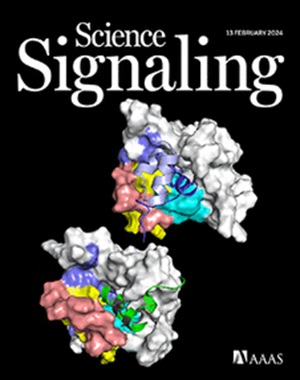SMAD2 S-palmitoylation promotes its linker region phosphorylation and TH17 cell differentiation in a mouse model of multiple sclerosis
IF 6.6
1区 生物学
Q1 BIOCHEMISTRY & MOLECULAR BIOLOGY
引用次数: 0
Abstract
The transcriptional regulators SMAD2 and SMAD3 share the same primary signaling pathway in response to the cytokine TGFβ. However, whereas SMAD2 stimulates the differentiation of naive CD4+ T cells into proinflammatory T helper 17 cells (TH17 cells), SMAD3 stimulates the differentiation of anti-inflammatory regulatory T cells (Treg cells). Here, we report a dynamic SMAD2-specific posttranslational modification important for TH17 cell differentiation. SMAD2, but not SMAD3, was reversibly S-palmitoylated at cysteine-41 and cysteine-81 by the palmitoyltransferase DHHC7 and depalmitoylated by the acyl protein thioesterase APT2. As a result, SMAD2 was recruited to intracellular membranes where its linker region was phosphorylated, leading to its interaction with the transcriptional regulator STAT3. Nuclear translocation of the SMAD2-STAT3 complex induced the expression of their target genes that promoted TH17 cell differentiation. Perturbation of SMAD2-STAT3 binding by inhibiting the palmitoylation-depalmitoylation cycle suppressed TH17 cell differentiation and reduced disease severity in mice with experimental autoimmune encephalomyelitis, a model of multiple sclerosis (MS). Thus, the S-palmitoylation–depalmitoylation cycle mediated by DHHC7 and APT2 specifically regulates SMAD2, providing insights into the functional differences between SMAD2 and SMAD3 and the distinct role of SMAD2 in TH17 cell differentiation. The findings further highlight DHHC7 and APT2 as potential therapeutic targets for the treatment of TH17 cell–mediated inflammatory diseases, including MS.
多发性硬化症小鼠模型中SMAD2 s -棕榈酰化促进其连接区磷酸化和TH17细胞分化。
转录调节因子SMAD2和SMAD3在响应细胞因子TGFβ时共享相同的主要信号通路。然而,SMAD2刺激初始CD4+ T细胞分化为促炎T辅助17细胞(TH17细胞),而SMAD3刺激抗炎调节性T细胞(Treg细胞)的分化。在这里,我们报告了一个动态的smad2特异性翻译后修饰对TH17细胞分化很重要。SMAD2,而不是SMAD3,在半胱氨酸-41和半胱氨酸-81位点被棕榈酰转移酶DHHC7可逆地s -棕榈酰化,并被酰基蛋白硫酯酶APT2可逆地去棕榈酰化。结果,SMAD2被招募到细胞膜内,其连接区域被磷酸化,导致其与转录调节因子STAT3相互作用。SMAD2-STAT3复合体的核易位诱导其靶基因的表达,促进TH17细胞分化。通过抑制棕榈酰化-去棕榈酰化周期来干扰SMAD2-STAT3结合,可抑制实验性自身免疫性脑脊髓炎(多发性硬化症(MS)模型)小鼠的TH17细胞分化并降低疾病严重程度。因此,DHHC7和APT2介导的s -棕榈酰化-去棕榈酰化周期特异性调控SMAD2,为SMAD2和SMAD3之间的功能差异以及SMAD2在TH17细胞分化中的独特作用提供了新的视角。这些发现进一步强调了DHHC7和APT2是治疗TH17细胞介导的炎症性疾病(包括MS)的潜在治疗靶点。
本文章由计算机程序翻译,如有差异,请以英文原文为准。
求助全文
约1分钟内获得全文
求助全文
来源期刊

Science Signaling
BIOCHEMISTRY & MOLECULAR BIOLOGY-CELL BIOLOGY
CiteScore
9.50
自引率
0.00%
发文量
148
审稿时长
3-8 weeks
期刊介绍:
"Science Signaling" is a reputable, peer-reviewed journal dedicated to the exploration of cell communication mechanisms, offering a comprehensive view of the intricate processes that govern cellular regulation. This journal, published weekly online by the American Association for the Advancement of Science (AAAS), is a go-to resource for the latest research in cell signaling and its various facets.
The journal's scope encompasses a broad range of topics, including the study of signaling networks, synthetic biology, systems biology, and the application of these findings in drug discovery. It also delves into the computational and modeling aspects of regulatory pathways, providing insights into how cells communicate and respond to their environment.
In addition to publishing full-length articles that report on groundbreaking research, "Science Signaling" also features reviews that synthesize current knowledge in the field, focus articles that highlight specific areas of interest, and editor-written highlights that draw attention to particularly significant studies. This mix of content ensures that the journal serves as a valuable resource for both researchers and professionals looking to stay abreast of the latest advancements in cell communication science.
 求助内容:
求助内容: 应助结果提醒方式:
应助结果提醒方式:


